PERU
Plants and Animals

Plants and Animals

Cities in PERU
| Lima |
Plants and Animals
Plants
The desert-like coastline is practically barren in some places, in other places the vegetation consists only of a few shrubs and low, thorny trees such as the algorrobo, an acacia species. A little further inland, the vegetation increases with many cacti, succulents and epyphites that attach themselves to rocks and other plants. Some examples are bromeliads, orchids and tillandsias.
When the sea mist hangs over the coast for a few months, the desert vegetation revives and bulbous plants such as lilies and begonias can be seen for a short time. Mangrove forests are found in the far north of the Peruvian coastal area.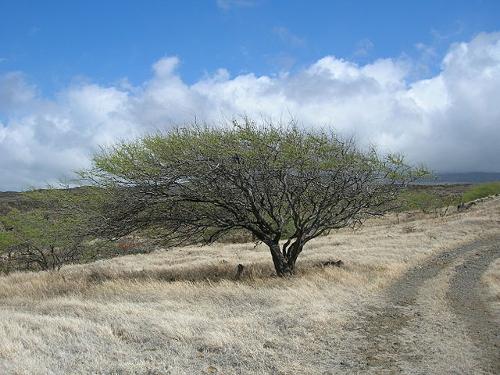 Prosopis pallida 'algarrobo' PeruPhoto: Forest & Kim Starr CC 3.0 Unported no changes made
Prosopis pallida 'algarrobo' PeruPhoto: Forest & Kim Starr CC 3.0 Unported no changes made
In the fairly dry valleys of the Andes, agaves, bromeliads and cacti, such as the candlestick cactus and the melon cactus, grow among others. The moister valleys have a varied vegetation, including different types of orchids and bromeliads. The rare giant bromeliad Puya raimondi grows at an altitude of 4500 meters, with a record stalk of up to ten meters on which some 20,000 flowers bloom once, before dying. One of the highest growing trees, the qeñoa or polylepis tree, can be found up to 5000 meters, along with large lupines and the rimarina, a protected ranunculus. Also special are the yaretas, mosses that grow close together in spherical structures, including the rare azorella cushions.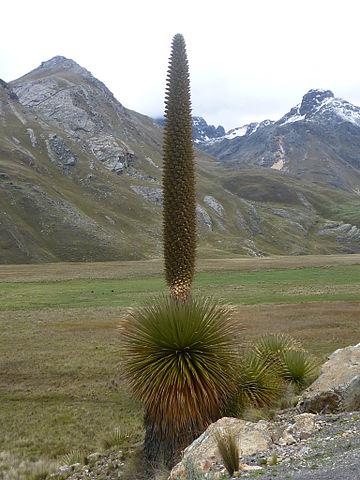 Puya Raimondi, Provincie Huaraz, PeruPhoto: Vane59 CC 3.0 Unported no changes made
Puya Raimondi, Provincie Huaraz, PeruPhoto: Vane59 CC 3.0 Unported no changes made
Many types of corn and potatoes can also be found in the Andes. We know 49 varieties of maize, hundreds of wild and cultivated varieties are known of the potato. The tree line in Peru is around 3500 to 4000 meters. The vegetation between the tree and snow line is called paramo or puna, depending on the amount of precipitation. Punavegatatie consists of grasses, (lichen) mosses and some herbs and shrubs.In the wet north of the Peruvian Andes the paramovegetations grow, besides grasses also mosses, ferns, herbs and shrubs grow here. Well-known plants here are the mountain bromeliads or puyas.
The dense cloud forests lie on the steep and humid slopes on the east side of the Andes. In this "Ceja de la Montaña it is often misty and a lot of rainfall. Many types of mosses, ferns, orchids and bromeliads grow on the trees of the cloud forest; long bearded mosses hang from the branches. Fuchsias, begonias, bomareas and slipper plants grow on the ground. In between there are meter-high tree ferns and mountain bamboo.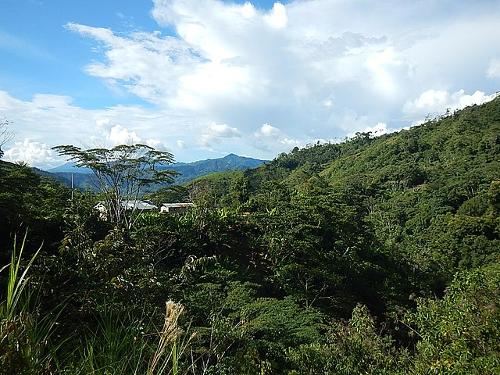 Rainforest in Satipo province, PeruPhoto: Mr AndrewHolmes CC 4.0 International no changes made
Rainforest in Satipo province, PeruPhoto: Mr AndrewHolmes CC 4.0 International no changes made
The cloud forest slowly changes into the tropical rainforests of the Amazon region. Here, among other things, about 2500 species of deciduous trees will be found, including 80 types of palms. The largest trees reach a height of 60-70 meters and often have enormous plank roots to support themselves. The crowns of these trees can be up to 30 meters in diameter, and often consist of small, thick, leathery leaves. Lianas, epyphites and parasites grow against the trunks of these forest giants. Under the trees grow many shrubs, ferns and foliage plants such as the striking heliconia, arum and wild ginger. Orchids often grow just below the canopy of tall trees.
Some typical cultivated crops for the Andes are the yuca and the rubber tree. Peru's national tree is the medicinal cinchona, which provides the raw material for quinine and is featured in the flag of Peru.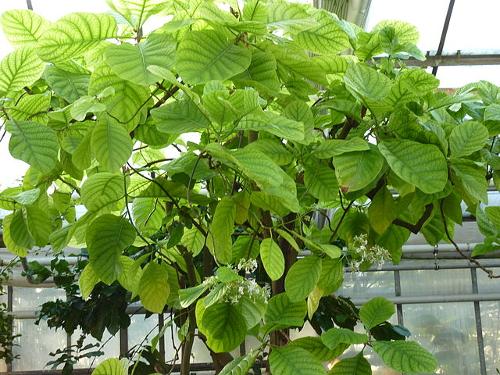 Cinchona tree, national symbol PeruPhoto: James Steakley CC 3.0 Unported no changes made
Cinchona tree, national symbol PeruPhoto: James Steakley CC 3.0 Unported no changes made
Animals
MAMMELS
The red howler monkey is a very noisy inhabitant of the Peruvian rainforest, living in groups of about 15 specimens up in the trees. The black spider monkey moves at great speed through the canopy of the jungle. Capuchin monkeys are highly intelligent; there are two species, the brown capuchin and the white-headed capuchin. Large groups of small squirrel monkeys also often live near the capuchin monkeys, often in the lowest layer of the vegetation.
Wool monkeys are often hunted because of the meat; the most common species in Peru is the gray wool monkey. The night monkey is the only nocturnal animal among South American monkeys. The little claw or dwarf monkeys often weigh no more than half a kilo, including marmosets, marmosets and lion monkeys. The saddlebacktamarins are most common in Peru, including the brown-mantled tamarin.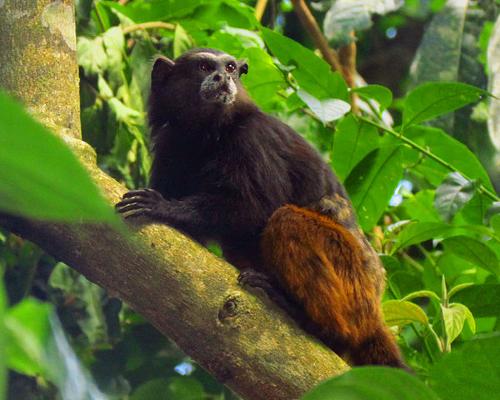 Brownmantled tamarin, subspecies of the saddleback tamarinsPhoto: D. Gordon E. Robertson CC 3.0 Unported no changes made
Brownmantled tamarin, subspecies of the saddleback tamarinsPhoto: D. Gordon E. Robertson CC 3.0 Unported no changes made
The toothless mammals are among the most characteristic of South America. Armadillos protect themselves from predators by their bony shield. The giant armadillo lives in the rainforests of the lowlands. The three Latin American anteaters are all found in Peru. The most common is the tamandua, rare are the giant anteater and the dwarf anteater. In the canopy live the slow two-toed sloth and the three-toed sloth hanging upside down from branches.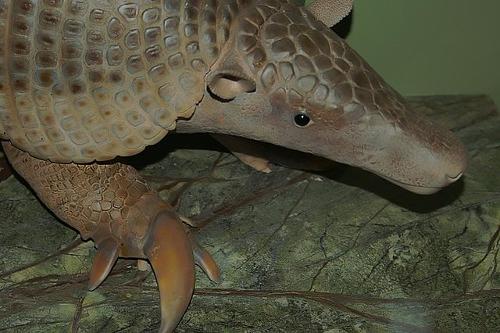 Giant armadillo, PeruPhoto: David J. Stang CC 4.0 International no changes made
Giant armadillo, PeruPhoto: David J. Stang CC 4.0 International no changes made
The most inaccessible forests and swamps are home to South America's most famous and largest feline, the jaguar. The cougar or mountain lion occurs to a very great height. Other Peruvian felines include the jaguaroundi, the ocelot, the tiger cat and the margay. The pampas cat is a typical animal of the mountain valleys, the Andean cat is very rare and only occurs in the southern highlands. The giant otter can reach almost 2 meters long, including a 70 cm long tail. There are only a few dozen copies left in Peru.
The black spectacled bear, the only bear species in South America, is very rare and is only found on the eastern slopes of the Andes. The skunk can be found up to 4100 meters, from the coast to the cloud forest on the east side of the Andes. The Andean fox is found throughout the Andean region and is slightly taller on the legs than its European and American counterparts. The Andean weasel attacks prey animals twice its size.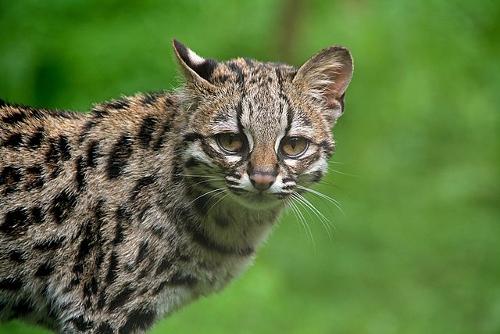 Margay, PeruPhoto: Clément Bardot CC 3.0 Unported no changes made
Margay, PeruPhoto: Clément Bardot CC 3.0 Unported no changes made
Of the four species of camelids, only the vicuña and the guanaco still live in the wild; the llama and alpaca were domesticated by the highland Indians of Peru thousands of years ago. The vicuña, the national animal of Peru, lives to a very great extent in southern Peru; the guanaco is now rare in the Peruvian highlands.
Rodents include the agouti, the mountain vizcacha (large chinchilla species) and the paca, after the capybara or water boar, the largest rodent in the world. A common animal is the wild guinea pig or "cuy". Ungulates include bristles such as the frilled peccary and white-lipped peccary, as well as the South American tapir, Peru's largest mammal. Typical forest animals are coatis or tejón. The Santuario Nacional de las Pampas del Heath reserve along the Bolivian border is the only place in Peru where the swamp deer roam. Two other deer species are quite common, the white-tailed deer and the "taruka", almost extinct and living at extreme altitudes. Two small species of deer live in the cloud forest, the dwarf spiked deer and the red-colored Pudua humilis.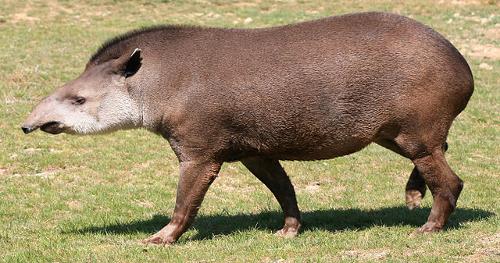 Lowland Tapir PeruPhoto:Jean-Marc Rosier from http://www.rosier.pro CC 3.0 no changes made
Lowland Tapir PeruPhoto:Jean-Marc Rosier from http://www.rosier.pro CC 3.0 no changes made
BIRDS
There are about 1800 bird species in Peru. The most impressive bird of prey in Peru, and also the largest bird of prey on earth, is the Andean condor with the largest wing area of all flying birds and with a wingspan of about three meters. Relatives of this giant are the black vulture, the king vulture and the turkey vulture. A striking bird of prey is the mountain caracara, a black and white bird with a red, bald face. The swallow-tailed kite is found from the Andean region up to the high mountains.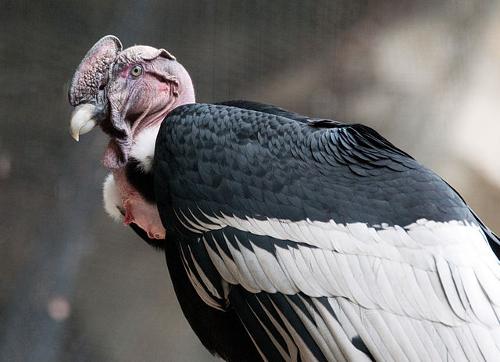 Andean condor, PeruPhoto: Eric Kilby from USA CC 2.0 Generic no changes made
Andean condor, PeruPhoto: Eric Kilby from USA CC 2.0 Generic no changes made
Peru's national bird is the red cock-of-the-rock, which lives in the cloud forests on the slopes of the Andes.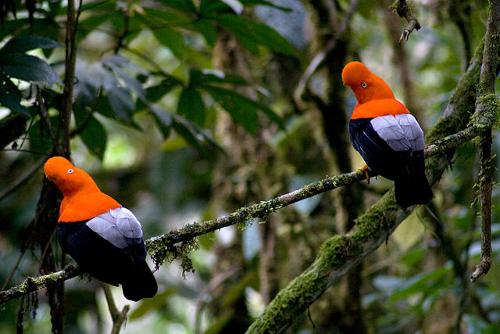 Red rockcock, national bird of PeruPhoto:Ricardo Sánchez CC 2.0 Generic no changes made
Red rockcock, national bird of PeruPhoto:Ricardo Sánchez CC 2.0 Generic no changes made
Other inhabitants of the cloud forest are the green jay, the collared jay, the fat bird and the Andean shakohoen, a large forest bird that mainly lives in the trees.
Two large toucan species are the Cuvier's toucan and the emerald arasaris. The largest parrots in Peru are the many types of macaws, including the blue-and-yellow macaw, the red-green macaw, the scarlet macaw, the red macaw and the green-wing macaw. Smaller parrots include the blue-headed parrot, Amazon, and white-eyed parrot.
Hummingbirds are only found on the American continents. About 50 species live in Peru, living both in the lowlands and on the highest peaks of the Andes. The oasis hummingbird lives in the oases along the coast, the collared Inca lives in the cloud forest area.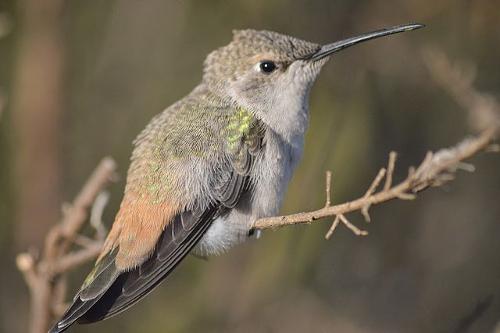 Atacama hummingbird, PeruPhoto: Ccelislagos CC 4.0 International no changes made
Atacama hummingbird, PeruPhoto: Ccelislagos CC 4.0 International no changes made
Large waders such as the great egret, white-necked heron, cow heron, gray-headed stork, pink spoonbill and the large but rare jabiru live in the lagoons and along rivers. Deep in the forest along the waterfront live five species of kingfishers, including the large ringed kingfisher and the small pygmy kingfisher.
The songbird order of Peru consists of more than twenty families and hundreds of species, such as nuthatches, oven birds, ant birds, mannequins, flycatchers, swallows, jays, wrens, mocking birds, blackbirds, weaver birds, tangars, finches and sparrows.
The scarlet blackbird lives around the mountain lakes and in the swampy valleys and at an altitude of 4000 meters there are, among others, the giant Andean coot, blue-billed ducks, grebes, gray herons, Andean gulls, the dark puna ibis and black Andean geese. The ant-eating ground woodpecker lives on the treeless puna's.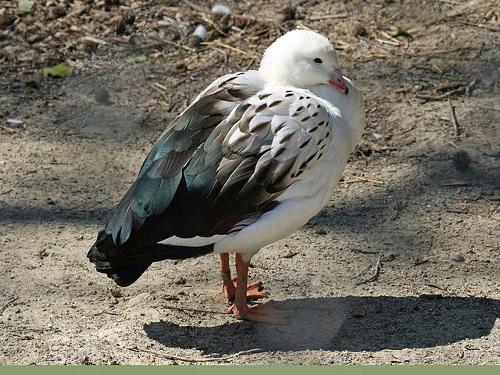 Andean goose, PeruPhoto: Dick Daniels CC 3.0 Unported no changes made
Andean goose, PeruPhoto: Dick Daniels CC 3.0 Unported no changes made
Oropendula's are troopials, which are common throughout the tropical lowlands and up to 2000 meters in the cloud forest. The special hoatzin is a large hen-like. The coastal desert is home to specialized fauna, including an owlet nesting in burrows in the ground.
Notable Amazon birds include the golden-headed quetzal, paradise thong, white-winged trumpet bird, jacana, harpy, pied-crested eagle, black-necked scotinga, tiger bittern, wire man, and American jassana.
REPTILES AND AMPHIBIANS
Peru's largest snake is the anaconda, which can grow up to eight meters long. Another large choke snake is the boa constrictor. The Peruvian poisonous snakes can roughly be divided into pit vipers such as the lance point snake or fer-de-lance and the colorful venomous coral snakes.
The most common crocodilian in Peru is the spectacled caiman and the twice the size but rare black caiman.The arrau is Peru's largest river turtle and the terekay is a smaller variety. There are many species of frogs in Peru, of which the colorful poison dart frogs are the most striking.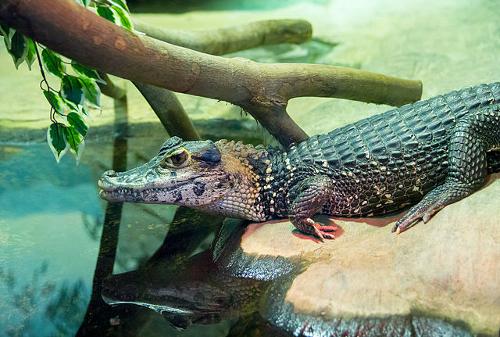 Black caiman, PeruPhoto: Rigelus CC 3.0 Unported no changes made
Black caiman, PeruPhoto: Rigelus CC 3.0 Unported no changes made
INSECTS
Hundreds of thousands of insect species live in the jungle of Peru. Most notable are stick insects, stick insects, lantern flies, termites and parasol ants.
FISHES
One of the largest fish of the Amazon is the Pseudoplatystoma fasciatum from the family of antennae traps. Piranhas are predatory fish that can be dangerous even to humans. The freshwater dolphins are harmless but curious. The "paiche" is a primitive fish that can reach a length of two meters and a weight of more than 80 kilos.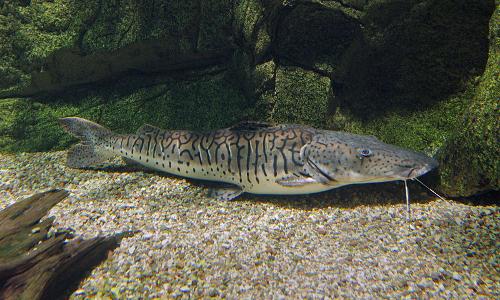 Pseudoplatystoma fasciatum from the family of antennae traps, PeruPhoto: Chrumps CC 4.0 International no changes made
Pseudoplatystoma fasciatum from the family of antennae traps, PeruPhoto: Chrumps CC 4.0 International no changes made
SPECIAL NATURE RESERVE
The Reserva Natural Paracas, which consists of a peninsula along the desert coast, is located near the western Peruvian city of Pisco. Off the coast are the Islas Ballestas, which is home to many sea birds, such as the brown pelican, the Humboldt penguin, the gray gull, the American oystercatcher, the black oystercatcher, the Inca tern, the frigate bird, the red-legged cormorant, the Humboldt booby and the Humboldt cormorant. The Chilean flamingo can be found here in May and June. Furthermore, around 25,000 sea lions and sea bears live here. Reserva Natural Paracas, PeruPhoto: Josue Hermoza CC 3.0 Unported no changes made
Reserva Natural Paracas, PeruPhoto: Josue Hermoza CC 3.0 Unported no changes made
In 1988, Peruvian scientists reported a new whale species, Mesplodon peruvianus, one of the smallest members of the whale family, measuring up to four meters in length.
Sources
Le Grand, J.W. / Peru : mensen, politiek, economie, cultuur
Koninklijk Instituut voor de Tropen : Novib
Luft, A. / Peru
Elmar,
Lyle, G. / Peru
Chelsea House Publishers,
Peru
Cambium,
Peru, Bolivia
Lannoo
Rensink, E. / Peru
Gottmer,
Te gast in Peru
Informatie Verre Reizen
CIA - World Factbook
BBC - Country Profiles
Copyright: Team The World of Info